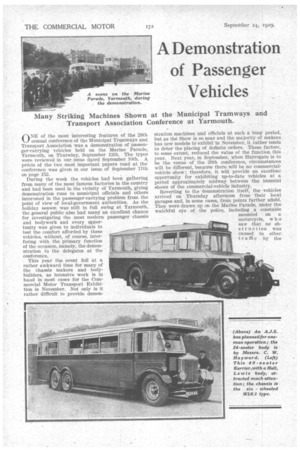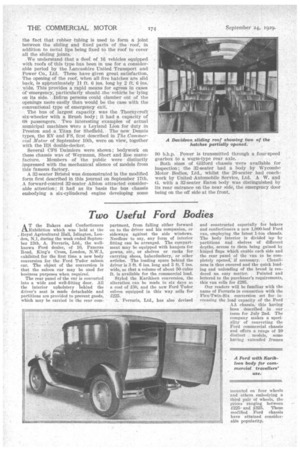A Demonstration of Passenger Vehicles
Page 52

Page 53

Page 54

If you've noticed an error in this article please click here to report it so we can fix it.
ONE of the most interesting features of the 28th annual conference of the Municipal Trapiways and Transport Association was a demonstration of passenger-carrying vehicles held on the Marine Parade,. Yarmouth, on Thursday, September 12th. The types were reviewed in our issue dated September 10th. A, prkis of the two most important papers read at the conference was given in our issue of September 17th on page 152.
During the week the vehicles had been gathering from many of the most famous factories in the country and had been used in the vicinity of Yarmouth, giving demonstration runs to municipal officials and others interested in the passenger-carrying problem from the point of view of local-government authorities. As the holiday season was still in full swing at Yarmouth, the general public also had many an excellent chance for investigating the most modern passenger chassis and bodywork and every opportunity was given to individuals to test the comfort afforded by these vehicles, without, of course, interfering with the primary function of the occasion, namely, the demonstration to the delegates at the conference.
This year the event fell at a rather awkward time for many of the chassis makers and bodybuilders, as intensive work is in hand in most cases for the Commercial Motor Transport Exhibition in November. Not only is it rather difficult to provide demon
stration machines and officials at such a busy period, but as the Show is so near and the majority of makers has new models to exhibit in November, it rather tends to deter the placing of definite orders. These factors, to some extent, reduced the value of the function this year. Next year, in September, when Harrogate is to be the venue of the 29th conference, circumstances will be different, because there will be no commercialvehicle show; therefore, it will provide an excellent opportunity for exhibiting up-to-date vehicles at a period approximately midway between the biennial shows of the commercial-vehicle industry.
Reverting to the demonstration itself, the vehicles arrived on Thursday afternoon from their local garages and, in some cases, from points farther afield. They were drawn up on the Marine Parade, under the watchful eye of the police, including a constable mounted on a motorcycle, w Ii o saw that no obstruction was caused to other traffic by the array of buses and coaches which lined the sides of the thoroughfare in question. ' Although the delegates did not leave the conference until about 4.45 p.m., most of the vehicles were ready for inspection at 2.15 p.m. and the general public made the best of the time,
In addition to the chassis and -vehicles which were announced in our issue dated Septethber 10th as being schednled to be there on that day, there were several of other makes present, including a 20-seater G.M.C. with a body by Waveney and Co., „Ltd., and another G.M.C. having a Strachan 28-seater -body ;
24-seater, with a body by Messrs' C. W. Hayward, of Wolverhampton, was shown in a form suitable for oneman operation. A Garrett four-wheeled trolley-bus had been equipped temporarily with a ." skate " for giving local demonstrations. This was necessary because the overhead wires were of the single type designed for trams, but the vehicle was able in the circumstances to attain a fair speed to, demonstrate the possibilities of the type of those interested.
Demonstrating a Used Vehicle.
Having a body by Hall, Lewis and Co., Ltd., was a 40-seater liarrier rigid six-wheeler of the WW1 type of 30-ft. overall length. The appearance of the front of. this vehicle was considerably enhanced by polished radiator shutters. Among the Crossley exhibits was a coach owned by a local operator, which had done a considerable mileage and was Offered voluntarily by the owner for a demonstration on the day in question to show how well the machine had stood up to its work. On the Crossley double-decker the luggage rack over the near-side wheel-arch attracted many favourable comments.
Three types of Vulcan bus were shown, the Duchess, Prince and Emperor, the last-named being the latest comer to the ranks and having a seating capacity of 51 persons. The extremely low step at the entrance was commented upon by all and sundry.
The largest exhibit of any one make consisted of six Guy machines. A noteworthy feattire,of,the-latest
four-wheeled type of Guy trolley-bus is that the transmission is offset; the axle pot being mounted close to the near-side spring, thus reducing the floor height materially and avoiding the necessity for cambering the floor in any way. Grouped nipples are used for chassis lubrication on the latest models, and a neat feature is the enclosing of the nipples in boxes so that partieles of grit cannot choke them. This point is often overlooked and trouble ensues when the springloaded ball valves become blocked by mud forced in when the grease gun is applied at each point.
Popular Chassis Exhibits.
So far as the general public was concerned, the largest crowds were attractecroy the chassis exhibits. These comprised a Tilling-Stevens petrol-electric chassis, the Guy trolley-buses and the Ransotne trolleybus made by Hammes, Sims and Jefferies, of Ipswich ; this was a six-wheeler having a bogie of the Thornycroft type.
Sunshine saloons were to be seen among the Thornycroft exhibits, whilst a very interesting pattern .was that made by Davidson , (Trafford Park), Ltd., Manchester. It was exhibited on a Leyland Lion chassis; the opening ?portion of the roof was composed of five separate hatches. To open these two milled-headed screws are rotated until the hatch is released from the near side of the roof. By pulling on the stout handrail attached to the underside of the hatch it can be slid over to the off side. Here it is locked into position by turning the two clamps through 180 degrees and screwing down the milled-headed screws.
It will be realized that any one or all of the hatches may be opened and that each is locked positively in the open or closed position, thus• preventihg any rattle. When in the closed position water-tightness is ensured by the fact that rubber tubing is usedto form a joint between the sliding and fixed parts of the roof, in addition to metal lips being fixed to the roof to cover
all the sliding joints. •
. We understand that a -fleeC of 16 vehicles equipped with roofs of this type has been in use for a considerable period by the Lancashire United Transport and Power Co., Ltd. These have given great satisfaction. The opening of the roof, when all five hatches are slid back, is approximately 11 ft. 6 ins, long by 2 ft. 6 ins. . Wide. This provides a rapid means for egress in cases of 'emergency, particularly should the ,vehicle be lying on its side. Infirm persons could clamber out of the
• openings more easily than would be the case with the conventional type of emergency" exit. •
• The bus of largest capacity was tile Thornycroft six-wheeler with a Brush body; it had a capacity of • 68 passengers. • Two interesting examples of actual .municipal machines were a Leyland Lion for duty in .Preston and a Titan for Sheffield. The new Dennis types, the EV and FS, first described in The Commercial Motor, of September 10th1 were on view, together with the HS double-decker.
Several 0E6 Daimlers were shown ; bodywork on these chassis was of "Weymann, Short and Roe manufacture. Members of the public were distinctly impressed with the mechanical silence of models from this famous -factory. A 32-seater Bristol was demonstrated in the modified form first described in this journal on September 17th. A forward-control 32-seater Albion attracted considerable attention; it had as its basis the bus chassis embodying a six-cylindered engine developing some gearbox to a worm-type rear axle. inspection; the 32-seater had a body by Wycom be Motor Bodies, Ltd., whilst the 26-seater had coachG. with a .32-seater Eaton body was distinguished by its rear entrance on the near side, the emergency door 90 b.h.p. Power is transmitted through a four-speed work by United--Automobile Service, Ltd. A W. and being on the off side at the front,
. Both sizes of Gilford chassis were available,




















































































































